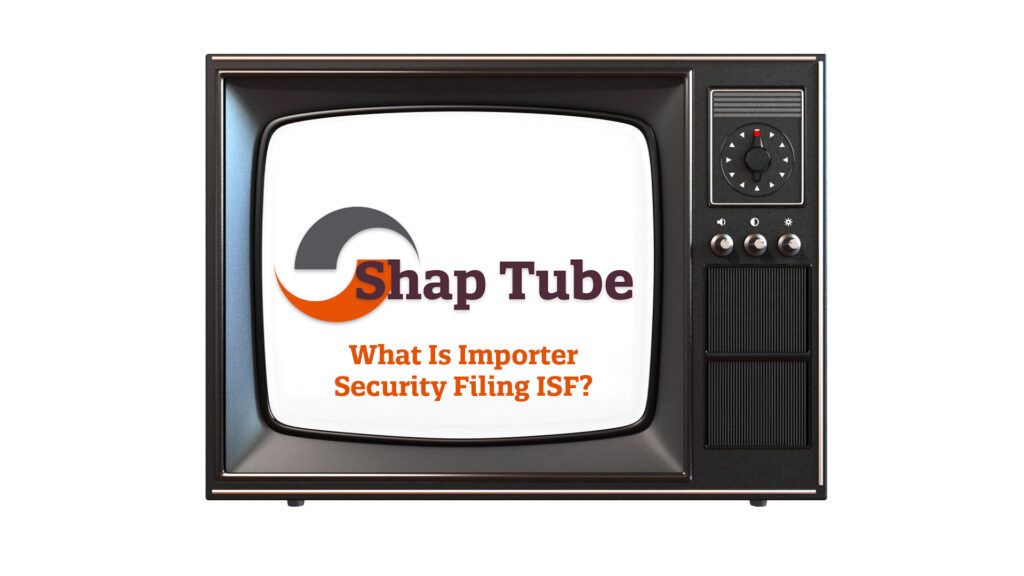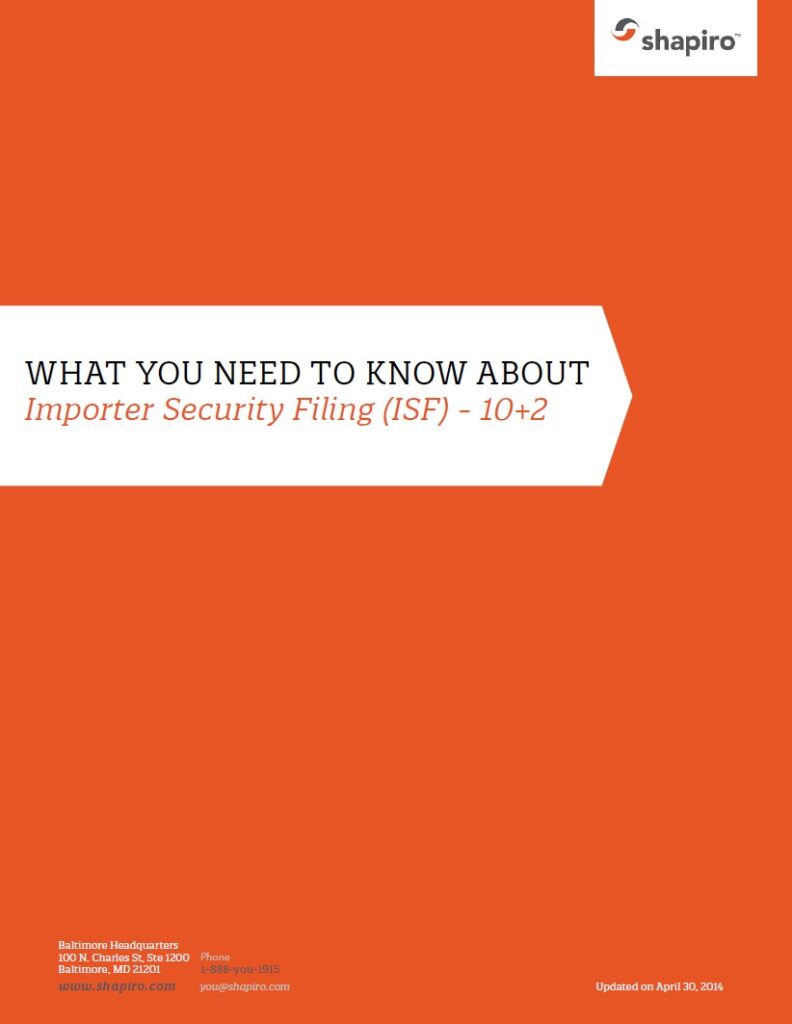What is Importer Security Filing (ISF) – 10+2?
10+2 is an entirely new business process expanding the importer’s sphere of accountability back to the point of stuffing. 10+2 is meant to enhance cargo targeting by requiring additional data elements prior to loading at the foreign port. Improved targeting of high risk shipments will result in fewer exams for low risk shipments. 10+2 further identifies the parties in the supply chain and dovetails with the 24 Hour Rule to provide more concise descriptions of commodities being shipped to the U.S.
10+2 is for security and targeting purposes only. It is not intended for commercial or trade enforcement purposes or for determining entry. However, Customs will be comparing the ISF to the entry data to analyze and assess risk and to validate the ISF data.
10+2 information is exempt from disclosure under the Freedom of Information Act (FOIA).
The official name of the program is “Importer Security Filing and Additional Carrier Requirements.” The Importer Security Filing (ISF) covers the “10” and the Additional Carrier Requirements cover the “+2.”
Customs had been contemplating a program like 10+2 for many years as part of their efforts to push supply chain security beyond our borders all the way back to the point of stuffing. The Security and Accountability for Every (SAFE) Port Act was passed in October 2006 and put into law the requirement to report advance cargo information prior to loading on vessels at foreign ports. A Notice of Proposed Rulemaking for 10+2 was published in January 2008. A Final Rule was published in November 2008. The effective date of 10+2 was January 26, 2009.
Three-Strike Leniency Strikes Out
Customs & Border Protection (CBP) at U.S. ports is no longer required to send requests for liquidated damages (LD) to its Headquarters for approval. Non-compliant Importer Security Filings can result in cargo holds at the port instead of, or in addition to, liquidated damage claims. Additionally, liquidated damage claims against importer bonds will no longer follow a “three-strike” leniency.
The new ISF enforcement will be applicable for all cargoes on the water on or after June 30, 2016.
10+2 Data Elements
- Seller – Name and address of the last known entity by whom the goods are sold or agreed to be sold. If the goods are to be imported otherwise than in pursuance of a purchase, the name and address of the owner of the goods must be provided. The seller information is generally available on the commercial invoice.
- Buyer – Name and address of the last known entity to whom the goods are sold or agreed to be sold. If the goods are to be imported otherwise than in pursuance of a purchase, the name and address of the owner of the goods must be provided. The buyer information is generally available on the commercial invoice. If the goods are sold in transit and the buyer information changes, the ISF must be amended.
- Importer of Record number/FTZ Applicant ID number – The IRS number, EIN, Social Security number, or Customs assigned importer number of the entity liable for payment of all duties and responsible for meeting all statutory and regulatory requirements incurred as a result of importation. For Foreign Trade Zone shipments, the IRS number of the party who files the documentation must be reported. If the importer of record on the entry is not the same as the importer that files the ISF, any ISF penalty would be against the party whose bond is posted for the ISF.
- Consignee number – The IRS number, EIN, Social Security number, or Customs assigned imported number of the individual or firm in the U.S. on whose account the merchandise is shipped.
- Manufacturer (or supplier) – Name and address of the entity that last manufacturers, assembles, produces, or grows the commodity. OR the name and address of the party supplying the finished goods in the country from which the goods are leaving. Remember that for textiles, the broker must have the actual manufacturer for entry purposes.
- Ship to party – Name and address of the first deliver-to party scheduled to physically receive the goods after the goods have been released from Customs custody. Customs believes this information will give predictability to targeting. If the ship to party is unknown, the facility where the goods will be unladen (e.g., pier) can be reported. If there are multiple delivery stop offs, only the first one is reported.
- Country of origin – Country of manufacture, production, or growth of the article, based upon the import laws, rules and regulations of the U.S. This is the same information declared on the Customs entry.
- Harmonized Tariff Schedule number – Tariff number under which the article is classified in the HTSUS. The final rule requires 6 digits, but Customs will accept 8 digits or the full 10 digit HTS number. This means all goods will need to be pre-classified.
- Container stuffing location – Name and address(es) of the physical location(s) where the goods were stuffed into the container. For break bulk shipments, the name and address(es) of the physical locations(s) where the goods were made “ship ready” must be provided. A “scheduled” stuffing location will be acceptable, but once the actual stuffing location is known, the ISF must be amended prior to arrival. The broker does not need to report which container was stuffed where (the container number is not required to be reported with the ISF).
- Consolidator (stuffer) – Name and address of the party who stuffed the container or arranged for stuffing of the container. For break bulk shipments, the name and address of the party who made the goods “ship ready” or the party who arranged for the goods to be made “ship ready” must be provided.
These are the “+2” data elements which are entirely the responsibility of the steamship line:
- Vessel stow plan
- Container status messages
The manufacturer, country of origin, and HTS number must be linked to one another at the ISF line item level. Customs will allow the entry/entry summary to be filed at the same time as the ISF.
Bill of Lading Number
In addition to the 10 ISF data elements, the broker must report the bill of lading number to tie the ISF to the manifest data and to the entry.
Who is responsible?
The ISF Importer is responsible for the timely, accurate, and complete submission of the 10 data elements in the ISF. The steamship line is responsible for the +2 container tracking reports. For FTZ shipments, I.E.s and T&Es, the party that files the documentation will be responsible for the ISF.
What kinds of shipments need 10+2?
10+2 is for ocean cargo only. An ISF must be filed for containerized cargo, break bulk shipments, and for Ro-Ro shipments. Bulk cargo (e.g., grain, coal, oil) is exempt. Goods arriving via vessel into Canada or Mexico and subsequently trucked or railed into the U.S. are exempt from 10+2.
When must the ISF be filed?
The following data elements must be filed no later than 24 hours before cargo is laden aboard the vessel at the foreign port:
- Seller
- Buyer
- Importer of record number/FTZ applicant ID number
- Consignee number
- Manufacturer/supplier
- Ship to party
- Country of origin
- HTS number
The following data elements must be filed as early as possible, but no later than 24 hours prior to arrival at the port of discharge:
- Container stuffing location
- Consolidator (stuffer)
ISF for break bulk cargo must be filed no later than 24 hours prior to arrival at the port of discharge.
ISF-5 – FROB, I.E. and T&E
Only 5 data elements are required for FROB (foreign cargo remaining on board), I.E. and T&E cargo. This type filing is known as ISF-5.
The data elements are:
- Booking party – Name and address of the party who initiates the reservation of the cargo space for the shipment.
- Foreign port of unlading – Schedule K port code is allowed.
- Place of delivery – the foreign location where the carrier’s responsibility for the transport of the goods terminates.
- Ship to party – Name and address of first deliver to party scheduled to physically receive the goods after the goods have been released from Customs custody.
- HTS number – It is not necessary to file the in bond paperwork before filing the ISF.
Amending/Canceling the ISF
If the ISF needs to be amended, it must be updated before the shipment enters the limits of the port of discharge. Only the party who originally filed the ISF is permitted to update the ISF. If you are converting a consumption entry to an I.E./T&E, then the 5 data elements (ISF-5) must be reported. The ISF may be deleted if the goods are no longer intended to be imported into the U.S. Only the party who originally filed the ISF is permitted to delete it.
Bonds and Penalties
The ISF Importer is required to post a bond to secure the timely, accurate, and complete ISF. Customs has amended the entry bond conditions to include ISF provisions where the importer agrees to comply with ISF requirements. An importer’s existing continuous bond will cover the Importer Security Filing. Importers without a continuous bond will need to post an ISF bond for each filing. Customs enforces ISF through the assessment of liquidated damages, in addition to penalties applicable under other provisions of law. Customs can assess liquidated damages up to $10,000.00 for violations such as failure to submit the ISF timely, accurately, or completely. Liquidated damages will be assessed against the holder of the bond posted for the ISF. C-TPAT status will be taken into account with mitigation.
Need Assistance with ISF 10 + 2?
Shapiro is here to help. Our experience with import regulatory compliance and global shipping is an asset to your import business. Contact us today to inquire about our services.


